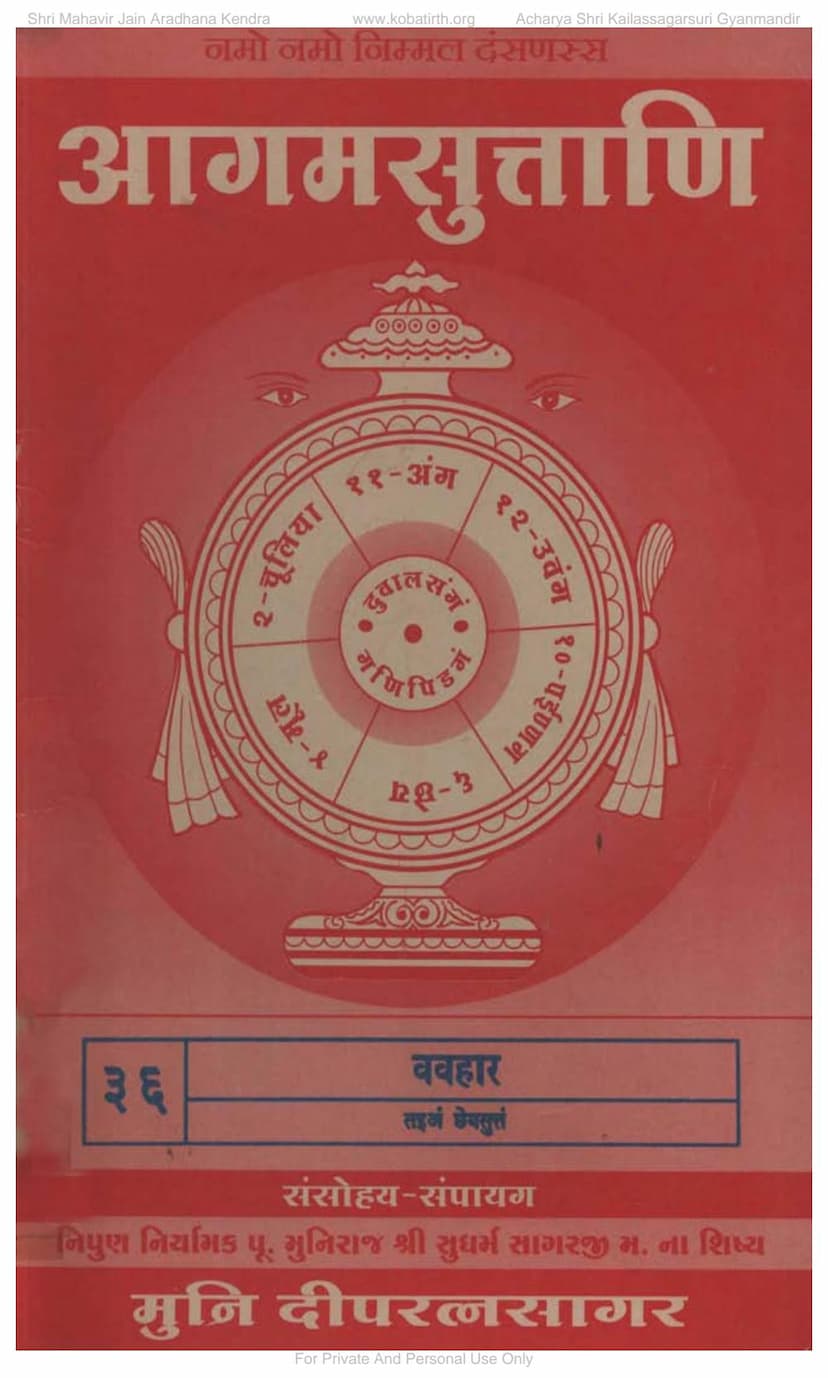Agam 36 Vavahara Chheysutt 03 Moolam
Added to library: September 1, 2025

Summary
This document is a Jain text, specifically Agam 36 Vavahara Chheysutt 03 Moolam, authored by Dipratnasagar and Deepratnasagar, and published by Agam Shrut Prakashan. The provided pages are from the first few chapters of this text.
Here's a comprehensive summary based on the content of the pages:
Overall Purpose:
The text is a Jain scripture that outlines rules and regulations for Jain monks and nuns (bhikshus and bhikshunis). It deals with various aspects of conduct, penance, and adherence to Jain principles. The specific sections visible focus on "Vavahara" (conduct) and "Chheysutt" (disciplinary rules or regulations).
Key Themes and Content:
-
Structure of Jain Agamas: Page 2 provides a glimpse into the classification of Jain Agamas, mentioning the 12 Angas (primary scriptures) and 12 Upangas (secondary scriptures), and then highlighting "Vavahara Sah Chheysuttam" as a significant part.
-
Sponsorship and Donations: Pages 3, 4, and 5 extensively list numerous individuals and Jain communities who have provided financial or material support for the publication of this Agam. This indicates a community effort to preserve and disseminate Jain knowledge.
-
The Core Text - Vavahara Chheysutt:
- Page 7 onwards (Uddeso 1): This section begins with prayers and then delves into specific rules related to "Parihar Sthana" (periods of penance or abstention). It details the consequences and durations of observing or failing to observe various penance periods (e.g., one month, two months, etc.). It specifies when a monk is considered to have committed a transgression and the subsequent purification or penance required.
- Pages 7-10 (Uddeso 1 continued): The rules become more nuanced, discussing:
- "Apalincha" and "Palincha" Alohana: Refers to confessing transgressions either directly or with some concealment.
- "Bahusovi" (Many times): The implications of repeating transgressions or periods of penance.
- Specific types of behavior: Rules are laid down for monks leaving the congregation, living alone, engaging in misconduct, or adhering to specific practices.
- Disciplinary actions: Terms like "Santara Chheya" (disconnection) and "Parihara" (penance) are mentioned, indicating a system of consequences for rule-breaking.
- Guidelines for Senior Monks (Thera) and their disciples: The text specifies when it's appropriate for a monk to seek permission from seniors for certain actions.
- Rules for ordained monks (Parihar Kappedie Bhikshu): Regulations regarding their interactions, movements, and duties.
- Repentance and Purification: The importance of confessing, condemning, and seeking atonement for transgressions is highlighted.
- Pages 10-15 (Uddeso 2, 3, 4): These sections continue to elaborate on various aspects of monastic conduct, including:
- Specific situations for monks and nuns: Rules for living together, leaving the community, and the qualifications and conduct of teachers (Acharya, Upadhyaya) and leaders (Ganachhediya).
- Rules regarding sickness and care: How to manage illness and the responsibilities of others towards a sick monk.
- Qualifications for teaching and leadership: The text specifies the required length of practice and knowledge for monks to hold teaching or leadership positions.
- Conduct related to sexuality and impurity: Strict rules are laid down for monks and nuns regarding any form of sexual misconduct or involvement, with severe consequences and periods of penance.
- Rules for movement and seasonal conduct: Guidelines for traveling, residing during the rainy season (Vasa Vasa), and performing religious observances.
- Pages 15-21 (Uddeso 5, 6, 7, 8): The focus shifts to more specific regulations concerning:
- The conduct of female ascetics (Pavattini, Ganavachhedini): Similar to the male monastic rules, these sections detail their qualifications and conduct.
- Accepting and rejecting items for alms: Rules about what can be accepted from householders and how to manage offerings.
- Personal conduct and purity: Regulations concerning diet, hygiene, and maintaining purity.
- The role of lay followers (Sagarie): Rules for lay disciples who support the monastic order.
- Disciplinary measures and penances: Further details on offenses and the prescribed atonement.
- Specific observances and practices: Mention of various types of vows and practices.
- Pages 21-28 (Uddeso 9, 10): These sections continue the detailed regulations, covering:
- Rules related to accepting food and drink: Specific guidelines on quantities, timing, and purity.
- Dietary regulations: Mention of different classifications of food intake.
- Types of alms and offerings: How to receive and manage alms from householders.
- Types of ascetics and their conduct: Classification of monks and nuns based on their practices and qualifications.
- The importance of scriptural knowledge: The text emphasizes the need for proficiency in Agamic knowledge for teaching and leadership.
- Conduct during specific times and circumstances: Rules for various situations, including health, travel, and interaction with the laity.
- The five types of "Vyavahara" (conduct): Agama, Shruta, Aana, Dharana, and Jiye.
-
Appendices and Indices: Pages 6 and 37-38 show the structure of the publication, including indices for subject matter ("Vishayanukkamo"), specific words ("Visishta Shabdhanukkamo"), proper names ("Vishesh Nam anukkamo"), verses ("Gathanukkamo"), and sutras ("Sutranukkamo"). These are invaluable for referencing and studying the text.
-
Publishing Information: Pages 2 and 35 provide details about the publisher (Agam Shrut Prakashan), printer, and the source of financial support, highlighting the collaborative effort behind the publication.
In essence, this document provides a foundational set of ethical and disciplinary rules for Jain monks and nuns, covering a wide range of daily activities, spiritual practices, and administrative duties within the monastic order. It underscores the Jain emphasis on purity, self-control, and the importance of adhering to scripture for spiritual progress.